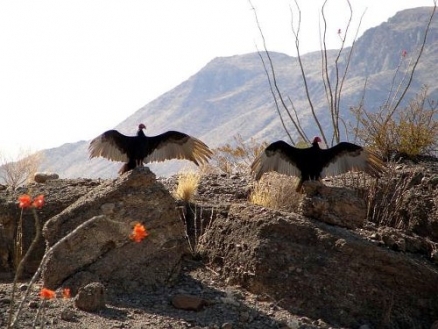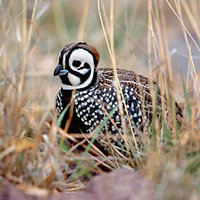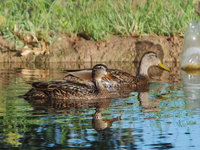Birds of Big Bend National Park
The Birds of Big Bend National Park evince desert beauty to impress the eyes of any individual. Throughout its 3110 square kilometer (1200 square miles) Texas site, one encounters vast canyons, immense mountains, and many different species of plants and animals. More than 450 different species of birds have been sighted within the territory of the park, making it an enormous attraction to birdwatchers throughout the country. Not only does it contain these species, but it is also the unique home to many of them. The birds living within the park have managed to adapt to the arid environment contained within the area. In order to understand these creatures, one has to grasp some knowledge over their environment, and what makes them capable of surviving within it.
Contents
Habitat
The Chisos Mountains, grasslands, and riparian zones along the Rio Grande are the three main areas where bird populations tend to be high within the boundaries of Big Bend National Park. Throughout the Chisos Mountains one can find extensive woodlands where the birds are able to nest. The canyons formed by these mountains contain many shrubs that serve as a habitat for these birds. The riparian zone along the river offers a completely different habitat for the birds that live in it. Thus, the birds that live within the stretch of the river tend to be very unique and different to those who live farther away.
Adaptations
It is easy to see how the birds living along theriver are quite different to those living in the desert. The river provides them with a different habitat, a more convenient source of water, bigger housing, and more places to hide. The increased variety of food within a riparian zone also allows the birds to specialize themselves over time to one kind of food. An example of this can be the woodpeckers, which are experts in capturing insects from the insides of trees. It is also and area where the coloration of the birds will differ. Under the trees and shrubs of a riparian zone, a bird is protected from the hot rays of the sun and darker colors are more prominent. Dessert birds tend to be lighter in color, and possess several adaptations to conserve water and lower body heat. As you follow along the different descriptions of Big Bend birds, notice how they differ from each other according their habitat and life style. How do they differ? What makes these differences and similarities happen?
Checklist of the Birds of Big Bend National Park
The checklist of the Birds of Big Bend National Park developed by the Big Bend Natural History Association in cooperationwith the National Park Service can be found at http://www.npwrc.usgs.gov/resource/birds/chekbird/r2/bbend.htm.
Species Guide
Montezuma Quail (Cyrtonyx montezumae)
Although not in danger of extinction, the population of Montezuma Quail within the Chisos Mountains, where they are mostly found, was eradicated in the early 20th century. Today most of the descendants have derived from introduced birds. They feed on mostly insects and plants that they forage from the ground. At night they roost on southeast slopes. Groups of these birds can be as big as 25 individuals, and they consist mostly of parents and offspring.
Locator Guide:
The Montezuma Quail is a fairly small bird, with a round body, short tail, and a distinct head pattern which both males and females share. It can be mostly found within opened woods, grasslands, and slopes of hills or canyons. Its calls are composed of a descending or shaky whistle.
Elf Owl (Micrathene whitneyi)
 Elf Owl. photo by Kate McKinnon http://katemckinnon.files.wordpress.com
Elf Owl. photo by Kate McKinnon http://katemckinnon.files.wordpress.com Although the Elf Owl is mostly found within the Sonoran Desert in Arizona, if has also been sighted within the boundaries of Big Bend National Park. The Elf Owl has remarkable hearing mechanisms that allow it to pin point the location of its prey. Special feathers along the base of its wings allow the bird to muffle the noises created when flying, making it an unnoticeable predator. They feed mostly on insects such as caterpillars, scorpions, crickets, moths, and beetles. Predators of the Elf Owl include other owls, snakes, coyotes, bobcats, and ringtail to nest in tree holes usually left behind from woodpeckers. Nests will be kept from 5 to ten meters above the ground (15 to 35 feet). They are nocturnal creatures.
Vermilion Flycatcher (Pyrocephalus rubinus)
 Vermillion Flycatcher. photo by Rolf Nussbaumer http://www.arkive.org/
Vermillion Flycatcher. photo by Rolf Nussbaumer http://www.arkive.org/ The male Vermilion Flycatcher initiates copulation by presenting its mate with an insect gift and displaying its flying capabilities. Land development is greatly reducing its native range, and thus population size. It spends 90 percent of its time perching for insects. The male Vermilion Flycatcher will undergo a dramatic transformation in color as it matures, going from brown gray feathers to the bright ones seen above. The species is known to be dimorphic, since males and females differ in color. In captivity, the male tends to loose its bright coloration.
Locator Guide:
Both males and females tend to grow up to 14 centimeters long (5.5 inches), and weight up to 14 grams (0.5 ounce). Males have a bright red head and under parts, while the female maintains the juvenile gray and brown coloration. They can be mostly found within the canyons and riparian woodlands of the Rio Grande.
Mexican Duck (Anas diazi)
A derived species from the Mallard Duck, the Mexican Duck is a main target for hunters. Although population numbers are of no concern, the population is experiencing a slight decrease in numbers due to the sport. The Mexican Duck feeds by grazing the water for plant food. These birds are usually monogamous, and form their pairs long before the spring breeding season. The Mexican Duck is known to dabble, or dip down, into the water to capture its food. They are also known to be very good swimmers, and spend most of their day in the water.
Locator Guide:
Both sexes are of similar size, 51 to 56 centimeters (20 to 22 inches), and they are similar in color. The Mexican Duck is brown with a yellow/blue beak. They highly resemble the female mallard duck, except they are slight bigger. It lives mostly in the river, but lays its eggs away from the water. In the winter, the Mexican Duck will migrate to southern Mexico.
Mexican Jay (Aphelocoma ultramarine)
 Mexican Jay. photo by Michael DiGiorgio http://fishcrow.com/mexican_jay.jpg
Mexican Jay. photo by Michael DiGiorgio http://fishcrow.com/mexican_jay.jpg The Mexican jay limits its habitat to the two major mountain ranges of northern México. It lives mostly in pine-oak forests. They are monogamous and thus only build nests, mate, and socialize with their partners. It will forage the ground for seeds, insects, or small lizards and is notorious for its ability to hide food and find it. Birds can be aged by fleshy colored areas on their beaks, which turn black as the bird reaches maturation. In the winter, the Northern Flickers follow around the Mexican Jay and benefit from their warning calls.
Locator Guide:
Both sexes share a similar size of 29 centimeters (11.4 inches), and weight 120 to 135 grams (4.2 to 4.8 ounces). The Mexican Jay has a blue head, wings, and tail with grayish blue back and dingy white underparts. Juveniles are pale gray with a pale bill. They are mostly found along the Chisos Mountains and oak forests within the park.
Big Bend Birding Resources
The Big Bend National Park offers many opportunities for bird watchers to enjoy the sight of different birds. From specialized birding trails to rafting expeditions down the Rio Grande, one is guaranteed a good exposition to the variety of birds found within the park. Another source is The Big Bend Birders of the Trans-Pecos of West Texas, a birding group that provides reports of bird sites within the area of Big Bend National Park. Visit Big Bend, is a publicity website sponsored by Brewster County, provides bird watchers with a bird sighting checklist and a list of birding hot spots within their website. One can also find information regarding necessary permits needed for hiking, canoeing, or rafting and with information links to local guiding tour companies.
Future Reading
- http://www.visitbigbend.com/whattodo_birding.html Brewster County Tourism Council “Visit Big Bend” Guide
- http://www.nps.gov/bibe/ US National Park Service Big Bend National Park Website
- http://www.allaboutbirds.org/netcommunity/Page.aspx?pid=1189 The Cornell Lab of Ornithology- Cornell University
- http://bigbendbirders.org/ The Big Bend Birders of the Trans-Pecos of West Texas
This article was partially researched by a student at Texas Tech University participating in the Encyclopedia of Earth's Student Science Communication Project. The project encourages students in undergraduate and graduate programs to write about timely scientific issues under close faculty guidance. All articles have been reviewed by internal EoE editors, and by independent experts on each topic.


